Just like the northern and western parts of India have the sev, crisp-fried spiced strands made of gram flour; South India has its own version of this quintessential Diwali favorite, popular as the Omapodi in Tamil Nadu and Karapusa in Andhra. So, this Omapodi Recipe also gives you a scrumptious crispy sev laced with the delicate flavor and aroma of carom seeds or ajwain. The addition of this is what makes it distinct than its other counterparts. Also, in Tamil Nadu, this spice is referred to as ‘omam.’ Hence, the name of this snack too.
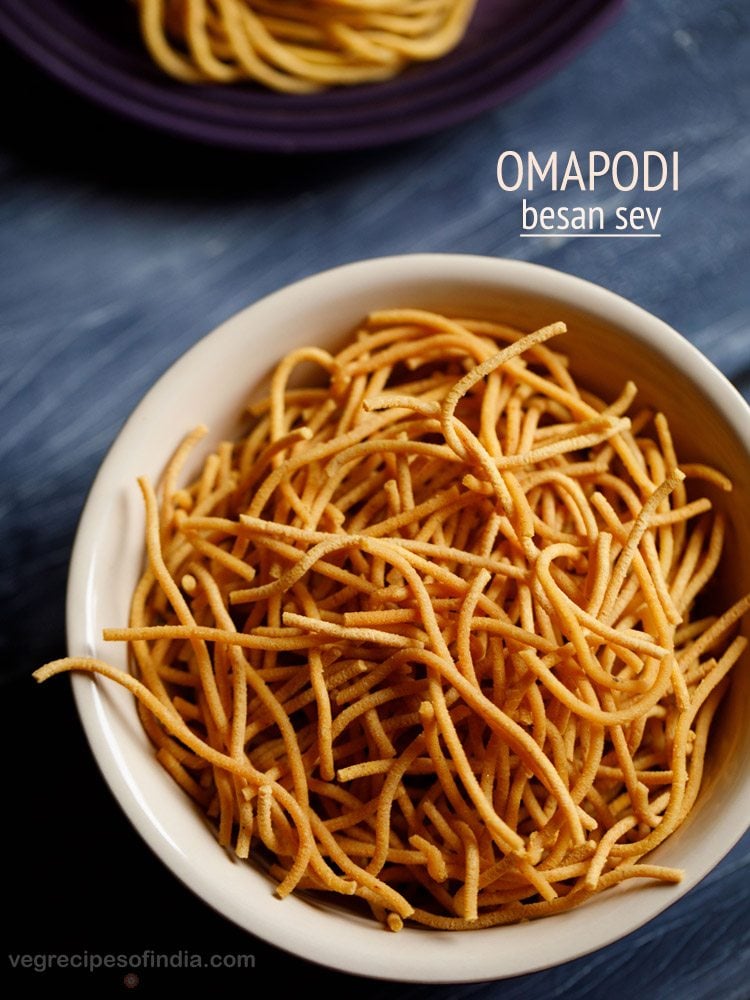
About Omapodi
Making the South Indian style sev called Omapodi is very easy and really does not need you to have much of an expertise in cooking. This is one of those common regional type of sev which is usually prepared as a festive treat during Diwali.
Apart from carom seeds or omam, which impart the typical flavor in it, other ingredients that you would need in this Omapodi recipe are gram flour, rice flour, some spice powders, seasonings and oil to deep-fry.
So, you see, you don’t even have to spend sleepless nights over sourcing of these ingredients as all of these are basic and are mostly available at our homes.
In this Omapodi Recipe, you can increase or decrease the degree of spiciness by altering the quantity of red chili powder.
A personal suggestion that I would like to share here is that avoid making this sev too spicy. As then, the taste of ajwain will eventually diminish and the snack will lose its essence.
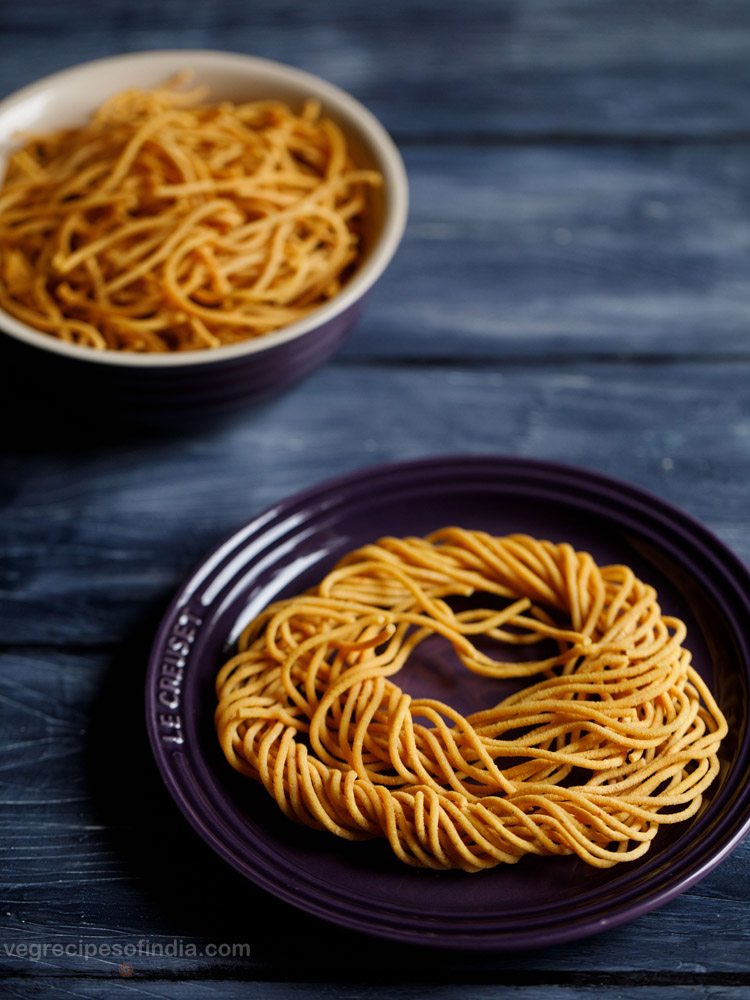
More On The Recipe
You can make Omapodi or Karapusa a few days before the Diwali festival and store in an air-tight jar or steel box or container. This Omapodi Recipe yields about 300 grams of this particular sev. You can also halve, double or triple the recipe to suit your requirements.
Not just a snack by itself, you can use this Omapodi Recipe to make it and then use it to make other popular preparations like this Madras Mixture and Kara Boondi Mixture.
It also makes for a great tea-time snack. You and your family and friends can munch on this carom flavored sev, any time of the day or enjoy even while watching a movie or reading a book.
Along with Omapodi, you can also give a try to these recipes of Potato Sev and Sev, which I have shared on this blog. Both these will also make for a fabulous snacky treat during your Diwali celebrations.
Step-by-Step Guide
How to make Omapodi
Preparation
1. Heat a small pan and keep the heat to low. Add 1 teaspoon carom seeds (ajwain).
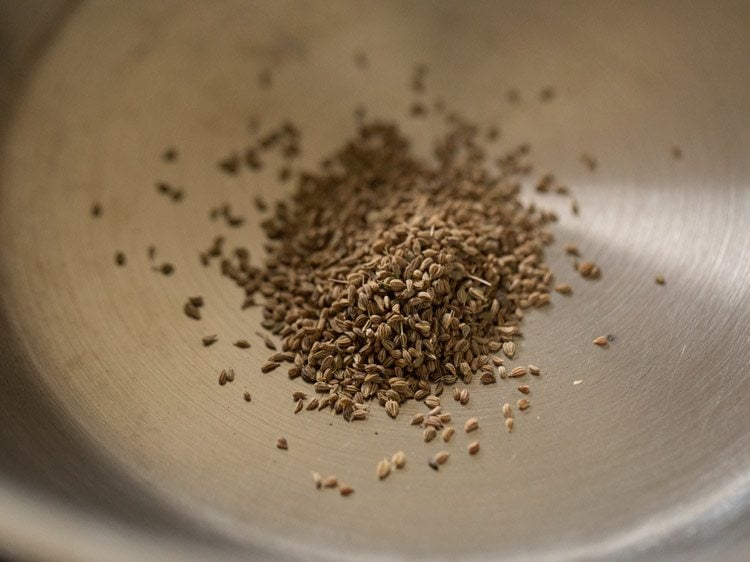
2. Stirring often, roast the carom seeds for some seconds or till they are fragrant. No need to brown the seeds. Set aside and let them cool.
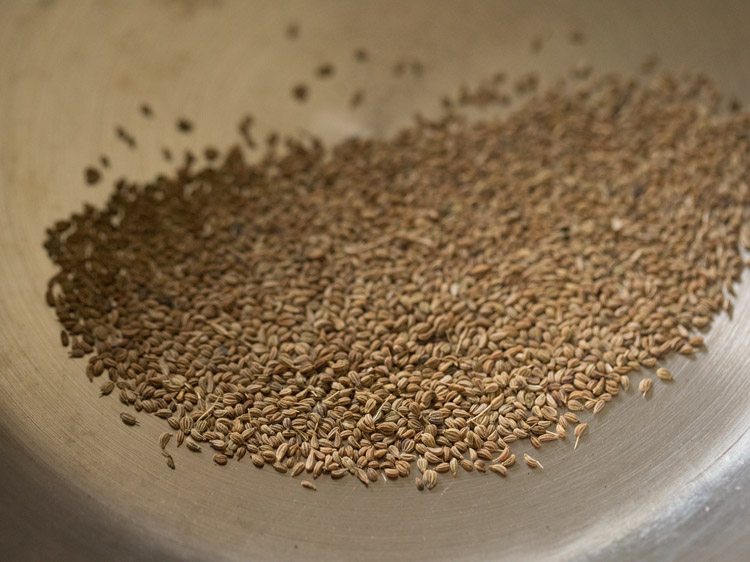
3. Once cooled, add the carom seeds in a small dry grinder jar or a spice grinder.
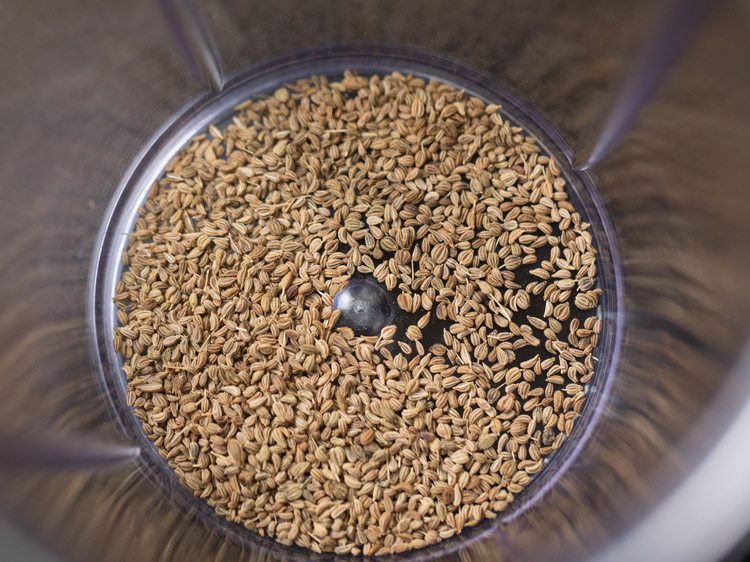
4. Grind to a fine powder. Set aside. You can also opt to crush or powder the carom seeds using a mortar-pestle.
In this scenario, when adding the crushed carom seeds powder, use a tea strainer and sift the powder through it. This helps the dough strands not to break while pressing the dough through the sev press or murukku press.
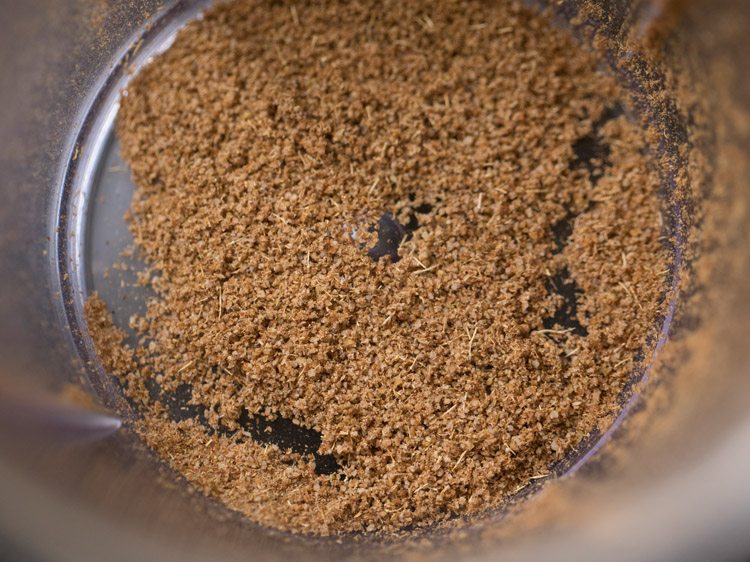
Make Dough
5. In a mixing bowl or pan, take 1 cup gram flour (besan) and ½ cup rice flour.
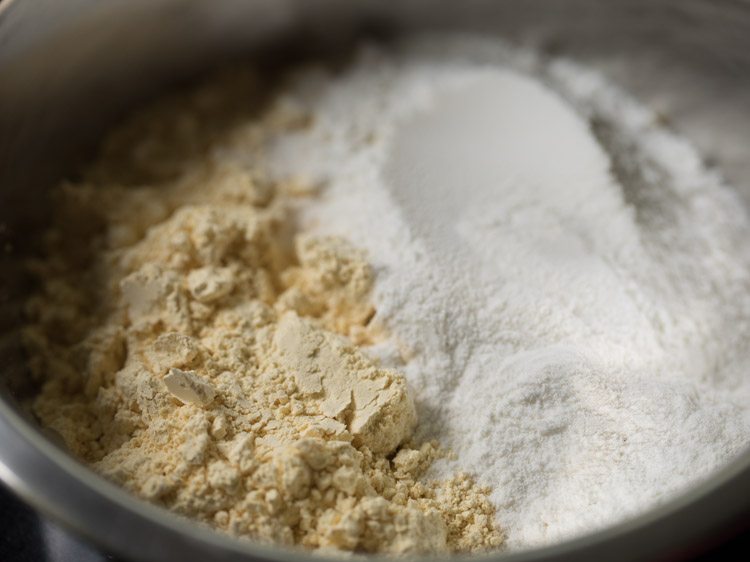
6. Add the prepared carom seeds powder.
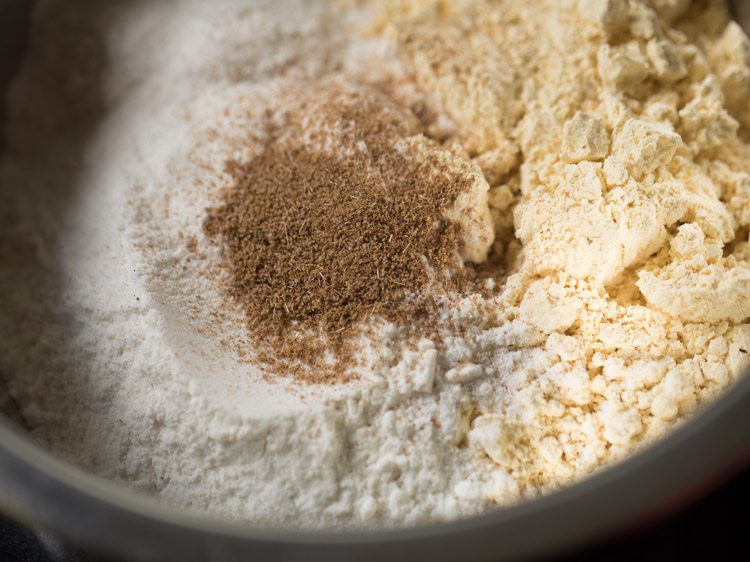
7. Add in 1 generous pinch asafoetida (hing), 2 pinches turmeric powder, ¼ teaspoon red chili powder and 1 teaspoon salt. You can add salt as per taste.
You can choose to omit turmeric powder if you prefer. To make a spicy omapodi, you can increase the amount of red chili powder. For more crispiness, you can add a pinch of baking soda also.
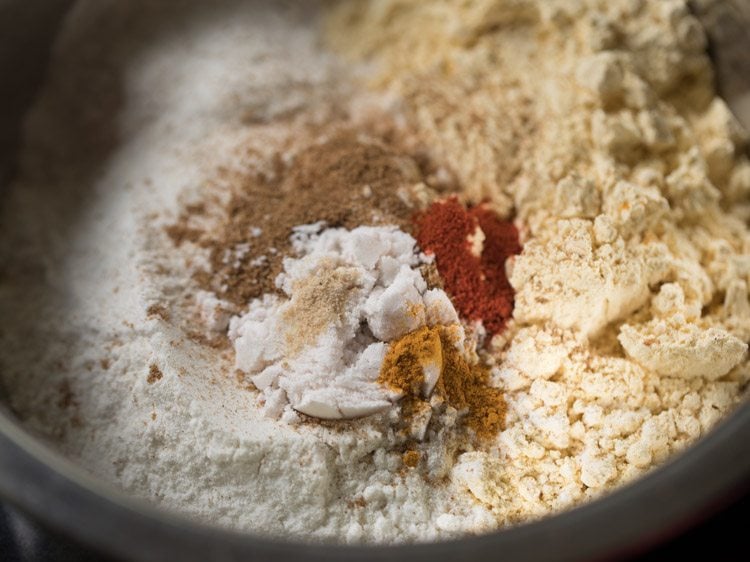
8. Mix the ground spices evenly with the flours using a spoon or spatula.
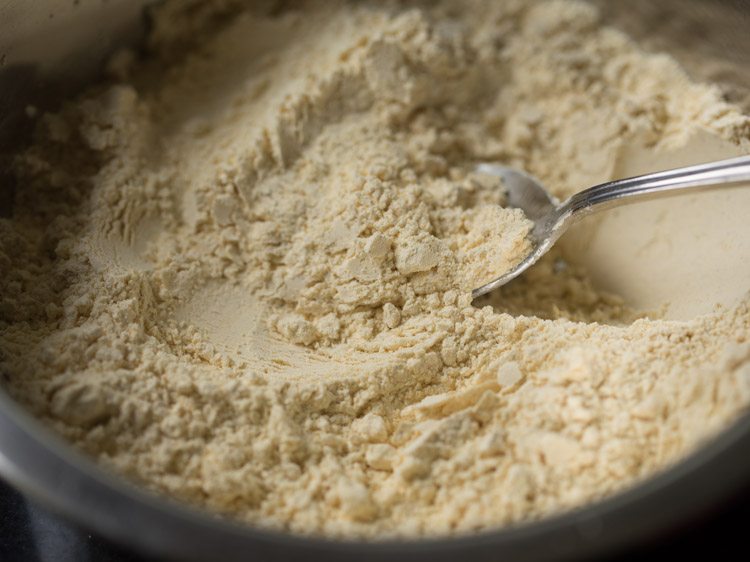
9. Next, heat 1 tablespoon oil in a steel bowl or a steel measuring cup.
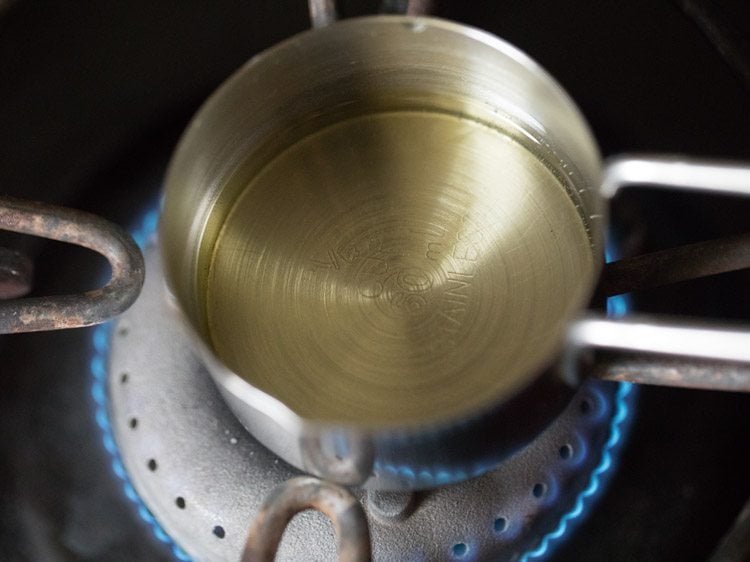
10. When the oil becomes hot, add it to the flour mixture. Instead of oil, you can also use ghee or butter.
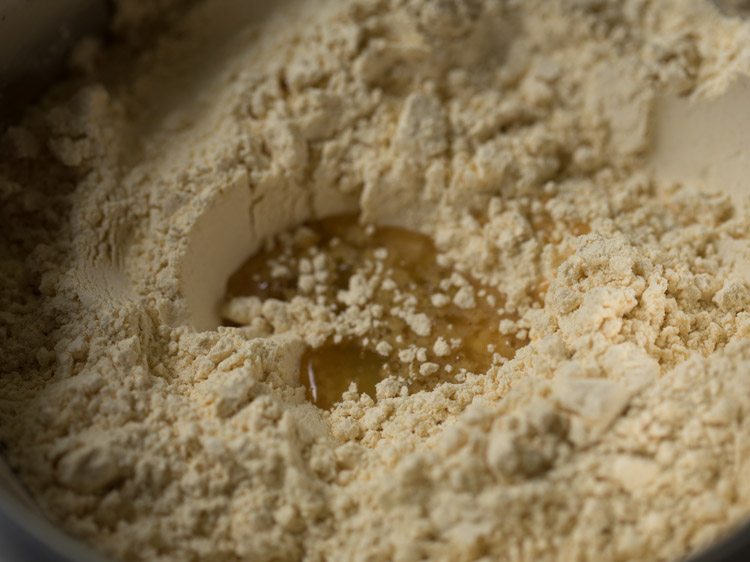
11. With a spoon, mix the oil with the flour mixture.
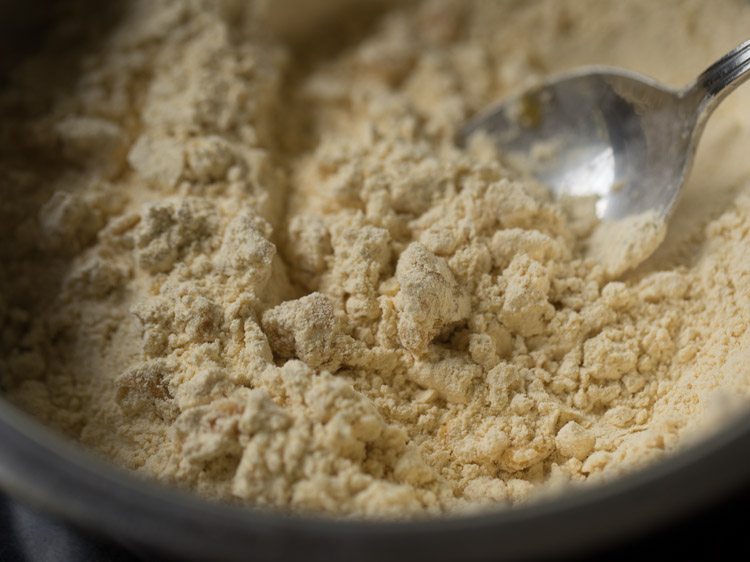
12. Next, add water in portions. First, add 2 to 3 tablespoons water. Mix well and begin to knead to a smooth dough.
I added a total of 7 tablespoons water. You can add 6 to 7 tablespoons water, depending on the quality of rice flour and gram flour.
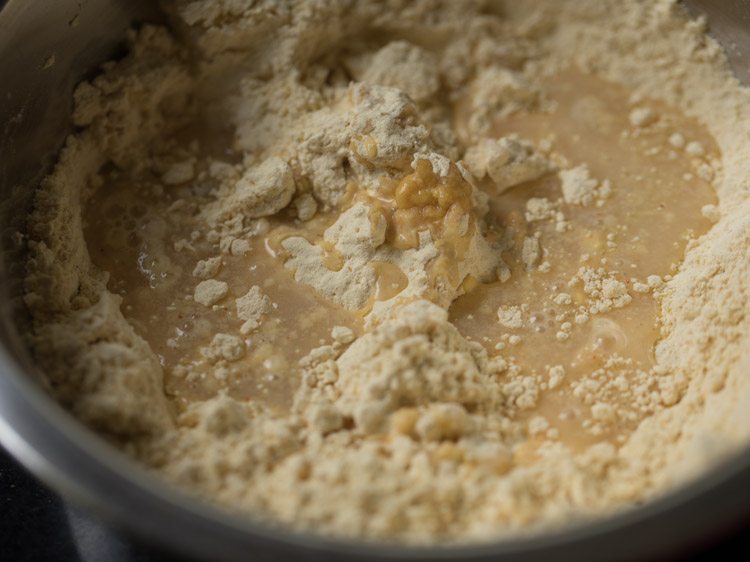
13. Knead to a smooth dough. If the dough becomes sticky, add some more gram flour. If the dough looks dry, then add some more water and knead again. Cover the bowl and set aside.
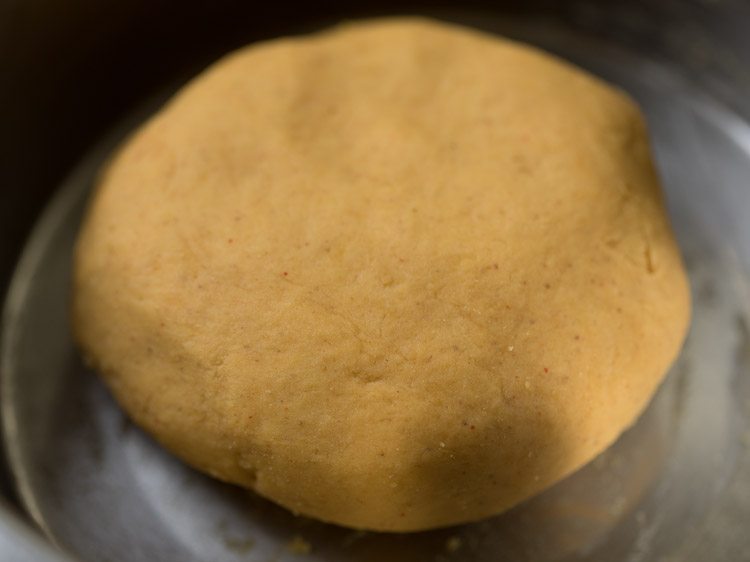
14. Use the disc shown in the picture below, for preparing omapodi. You can even use the disc with fine holes. Heat a kadai or pan and add oil as required for deep frying.
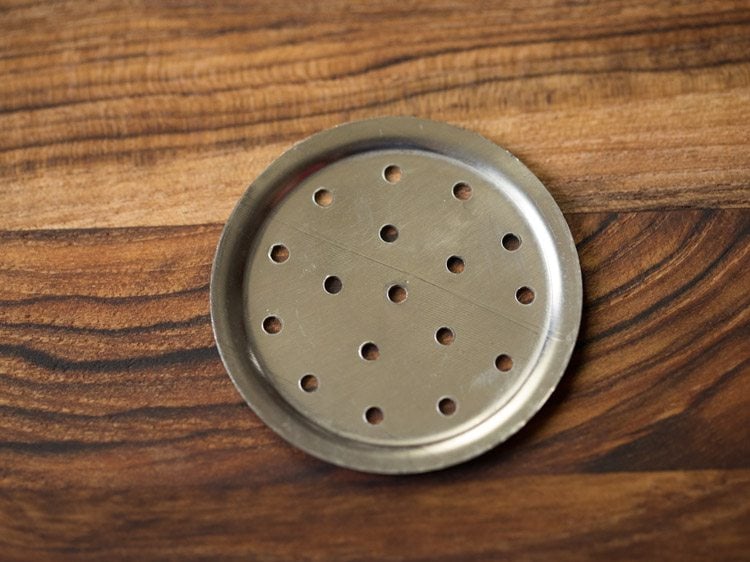
15. Apply some water or oil in the sev press or murukku maker. Then, take a portion of the omapodi dough and place it inside the sev maker. Cover with the top part and keep aside.
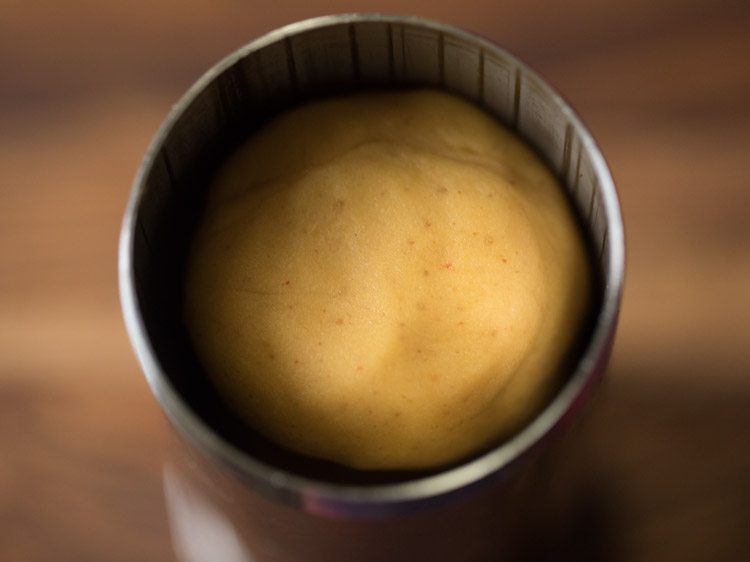
Fry Omapodi
16. Let the oil in the kadai become medium hot. Check the oil temperature by adding a tiny piece of the dough.
If the small piece comes up gradually and steadily on top, the oil is hot enough to fry. In case it comes up too quickly, then oil is too hot.
If it settles down at bottom of kadai or comes up very slowly, the oil is not hot enough for frying.
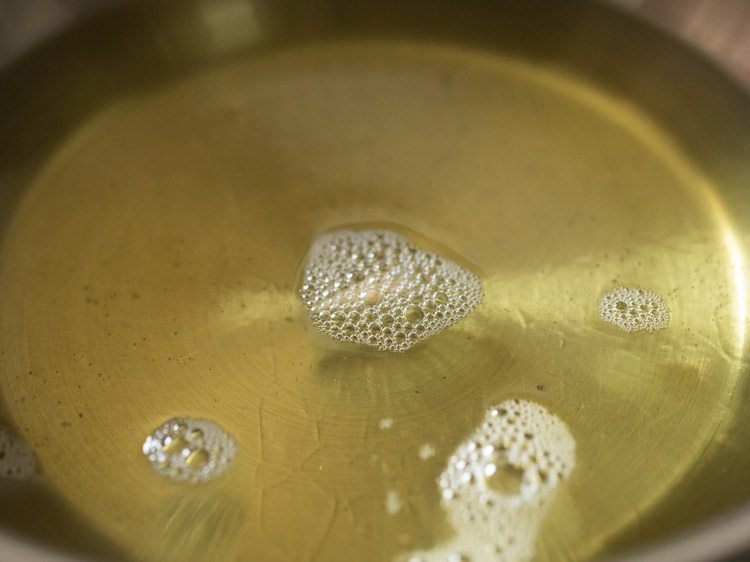
17. When the oil is hot enough, directly press holding the sev maker on top of the oil and let the dough strands directly fall in the oil.
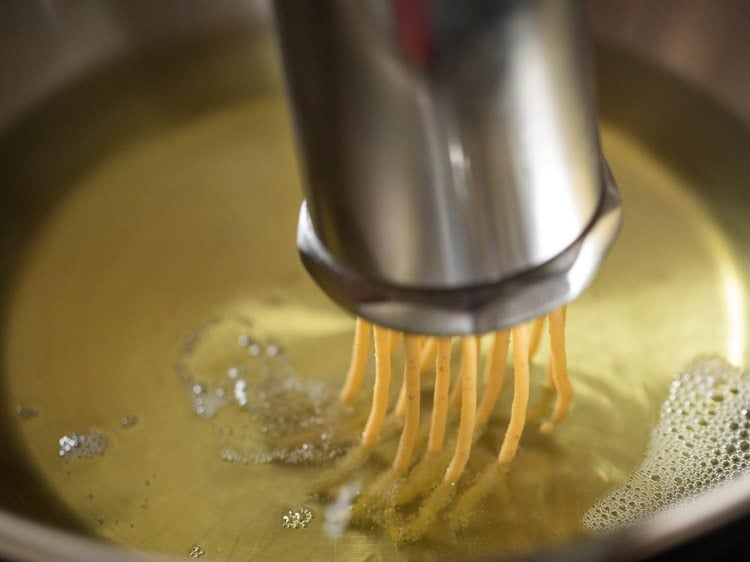
18. While pressing, rotate in a concentric circle from the center to outwards. Do not over crowd the kadai with the dough strands. Be careful when pressing the omapodi in the hot oil.
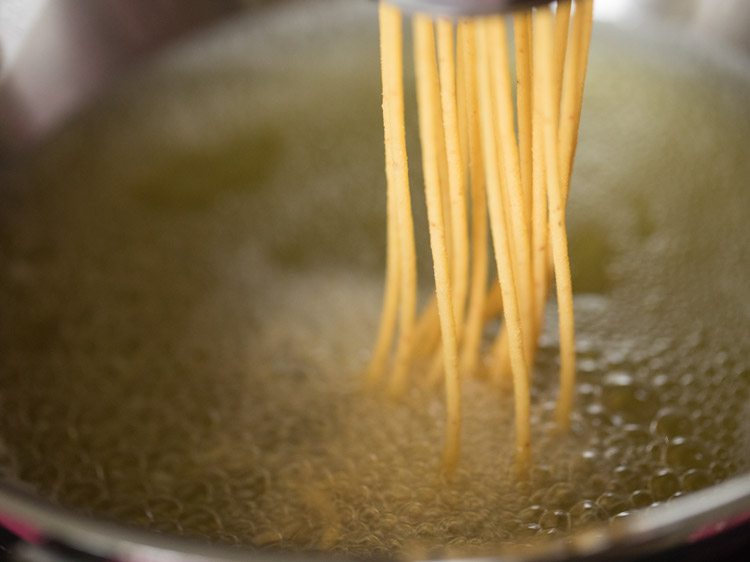
19. After it is is pressed in the oil, break the top dough strands with a spoon or knife and let the strands fall in the oil.
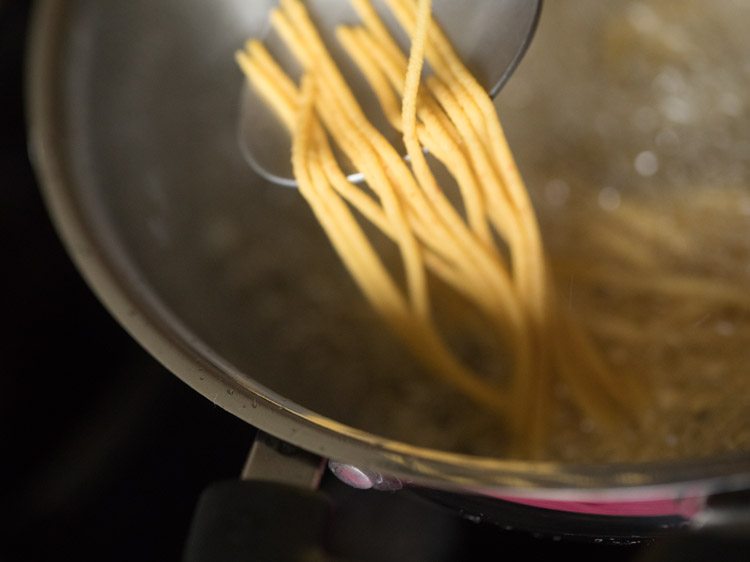
20. After adding the dough strands, do not touch immediately with the slotted spoon as they will break. Let them get fried first for a minute.
They need to become crisp first and then you can turn them over with the slotted spoon.
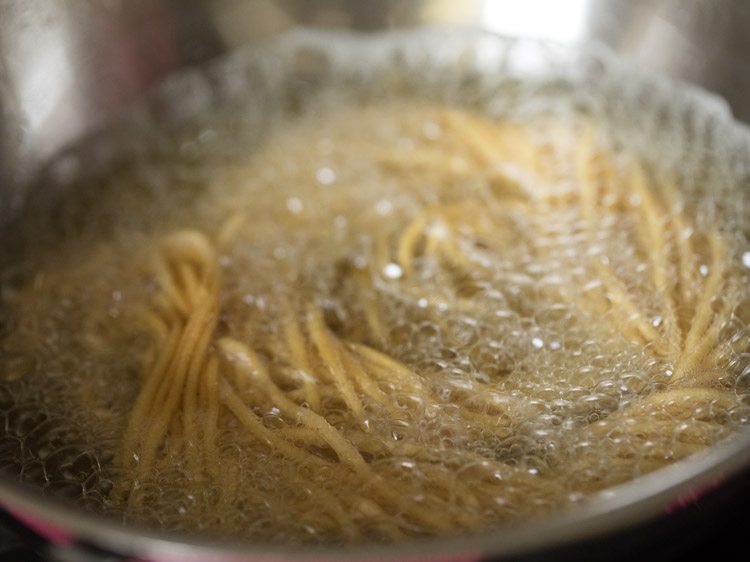
21. Gently begin to turn with a slotted spoon.
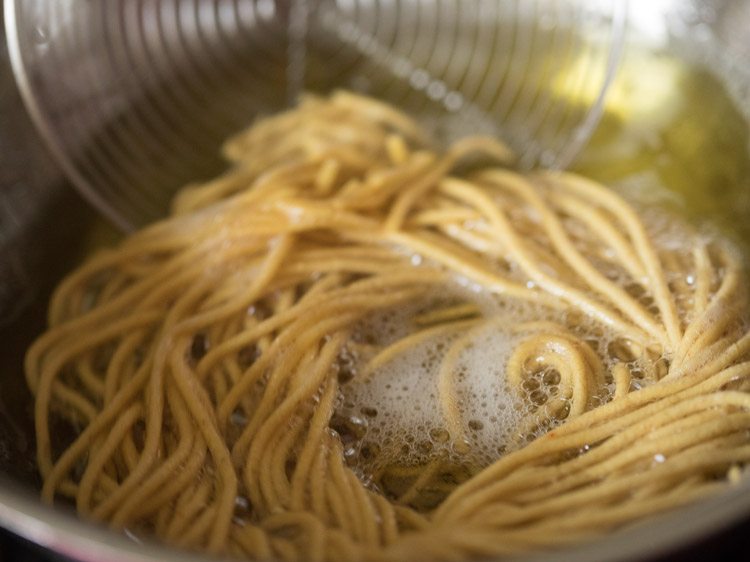
22. Now, fry the second side.
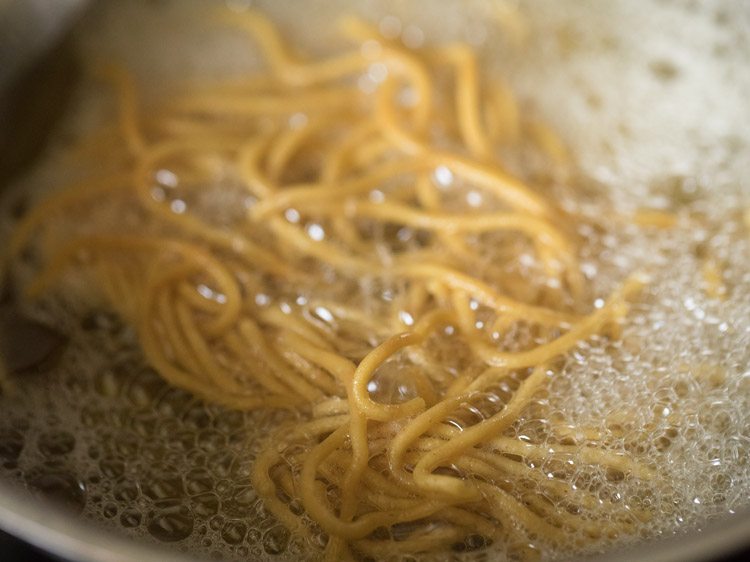
23. You can turn over a couple of times for even frying.
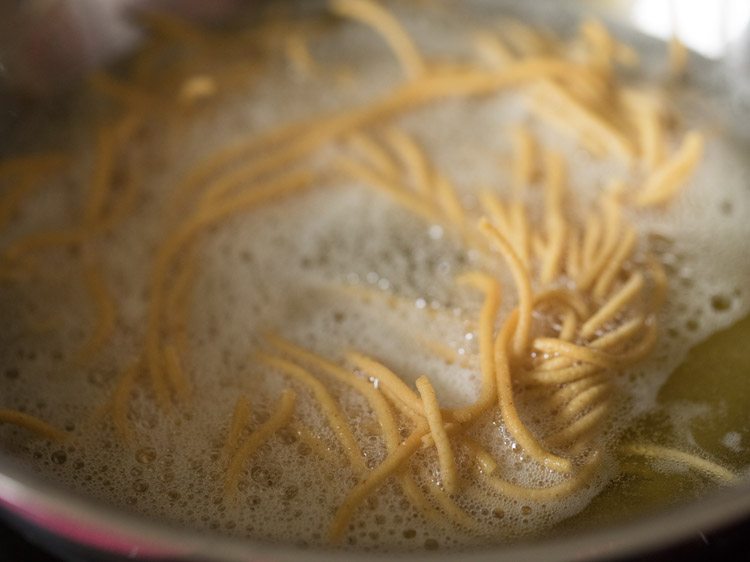
24. When the oil stops sizzling, continue to fry for some more seconds till the omapodi is golden and crisp. Turn over as needed, when frying.
Do not break omapodi or karapusa while frying as then it becomes an extra work to remove the small pieces from the oil. So, fry the entire round shaped omapodi as one piece and do not break it.
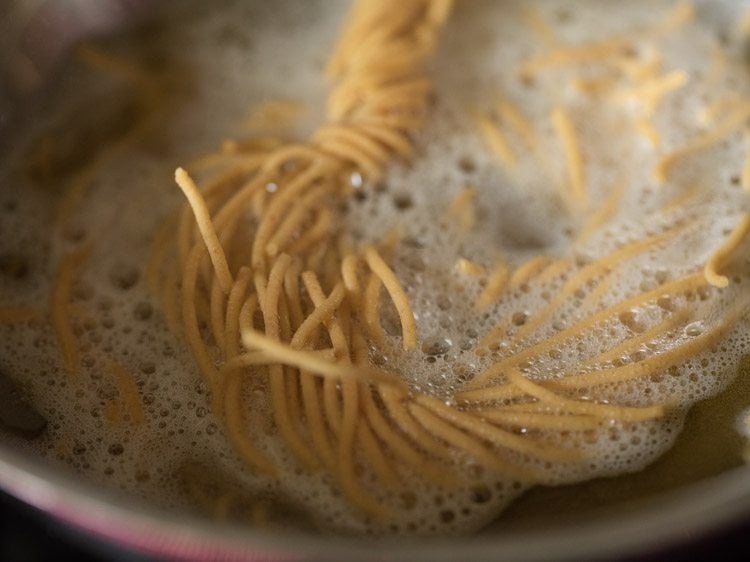
25. Once done, remove fried omapodi with a slotted spoon or a strainer spoon draining off the extra oil.
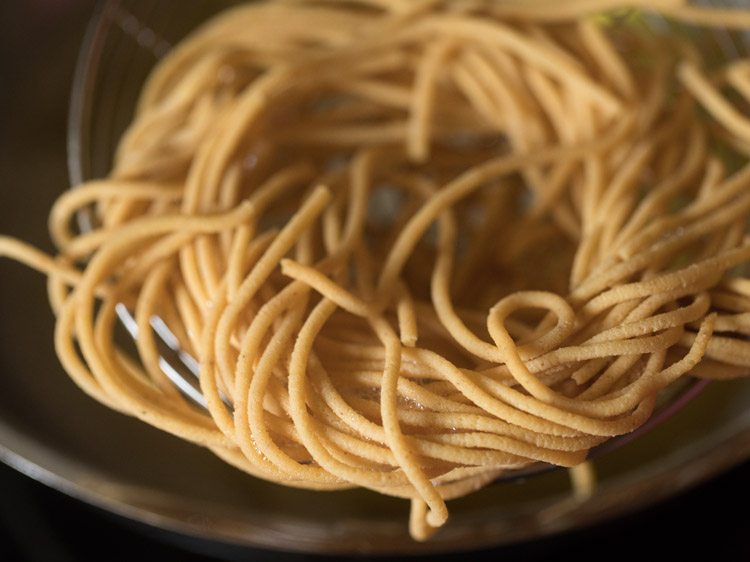
26. Place fried Omapodi on kitchen paper towels. Fry the remaining omapodi in batches in the same way.
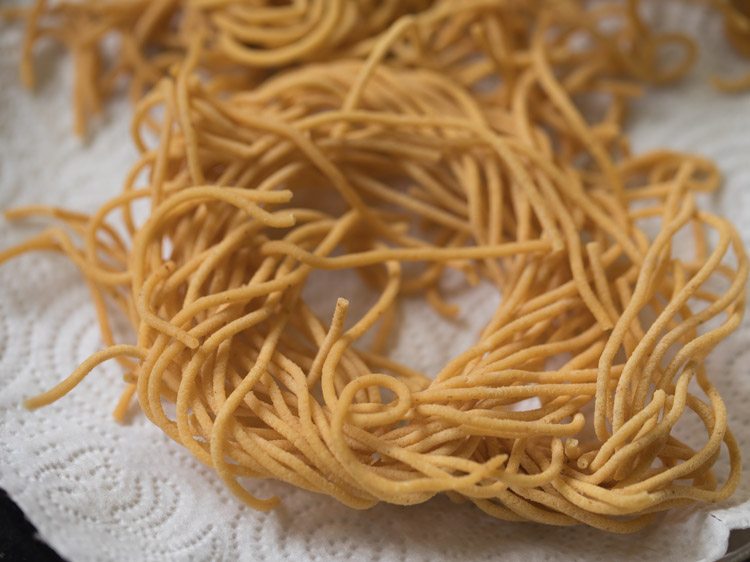
27. When it cools, place in an air-tight container or box. Now, while placing it in the container, you can break it, if you want.
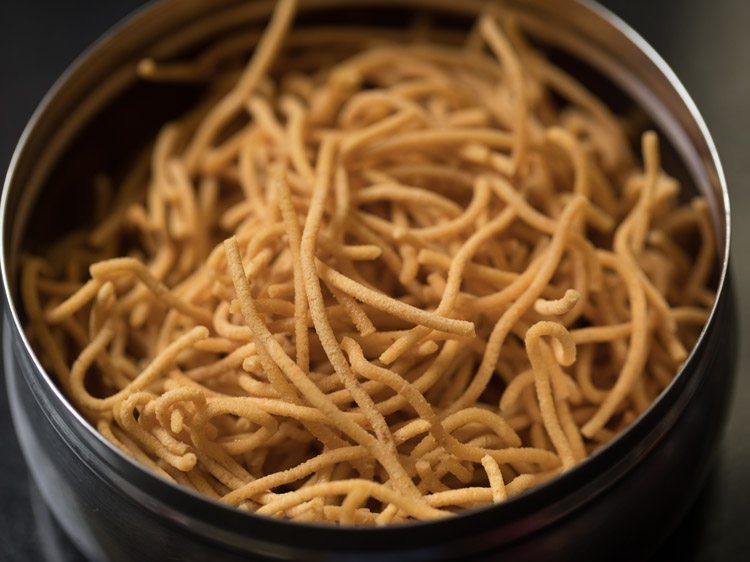
28. Serve Omapodi as a Diwali snack or tea time snack.
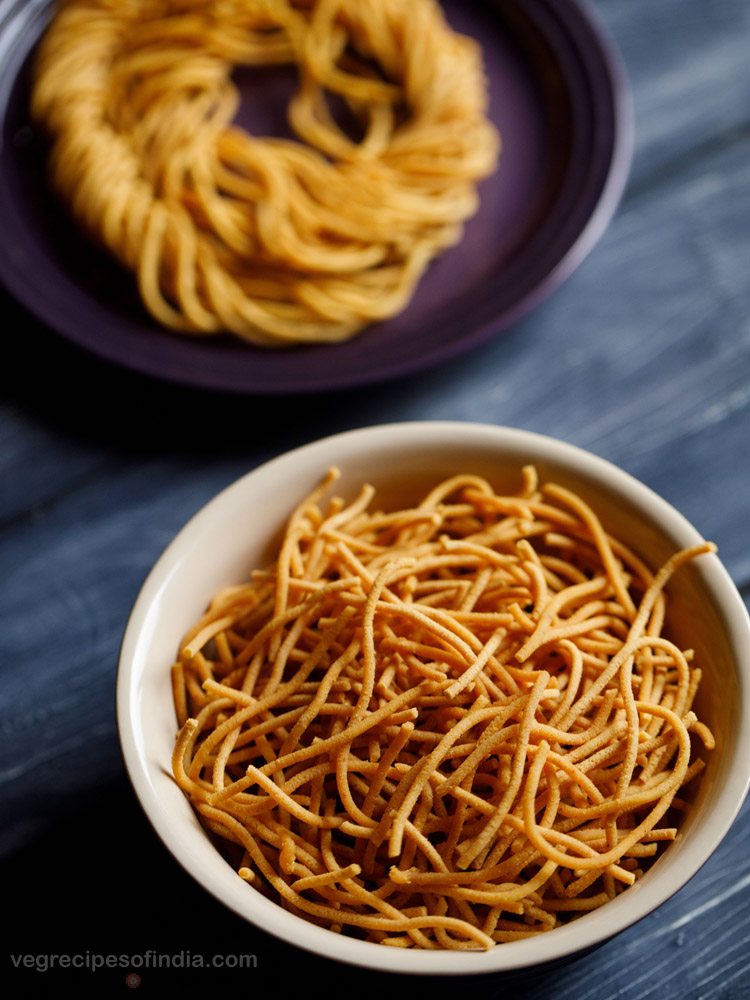
Expert Tips
- For spicier Omapodi, increase the quantity of red chili powder according to your taste preferences.
- You can skip adding the turmeric powder if you prefer.
- To make crispier Omapodi or Karapusa, add a pinch of baking soda to the dough.
- Instead of hot oil, you can even add hot ghee or butter to the flour mixture.
- Quantity of water to knead the omapodi dough will depend on the quality of gram flour and rice flour. If dough is sticky, add more gram flour and knead. If dry, add more water and knead. You have to knead the dough to a smooth consistency.
- Once you add this sev in hot oil, don’t touch them immediately with the slotted spoon as they will break like this. Fry for a minute first, or till it becomes crisp. Then, use the slotted spoon to turn.
- You can scale or halve the recipe, without any stress.
More Diwali Snacks Recipes To Try!
Please be sure to rate this recipe in the recipe card below if you have made it. For more vegetarian inspirations, Sign Up for my emails or follow me on Instagram, Youtube, Facebook, Pinterest or Twitter.
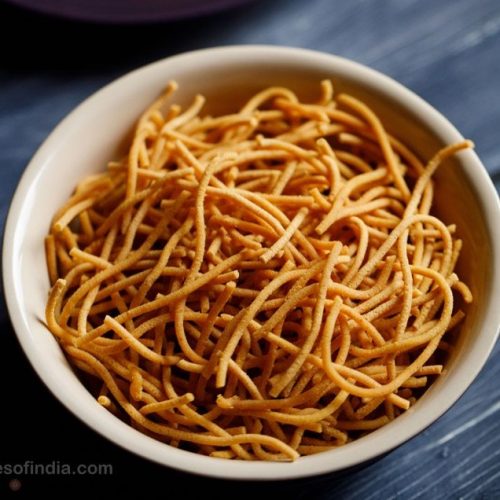
Omapodi Recipe (Karapusa)
Omapodi or Karapusa is a delicious and crispy South Indian snack of sev laced with the aroma and flavor of ajwain or carom seeds.
Prep Time 10 mins
Cook Time 20 mins
Total Time 30 mins
Prevent your screen from going dark while making the recipe
Preparation
Heat a small pan and keep the heat to a low. Add 1 teaspoon carom seeds.
Stirring often roast carom seeds for some seconds till they are aromatic. No need to brown them. Set aside and let them cool.
When cooled, add them in a small dry grinder jar or a spice grinder.
Grind to a fine powder. Set aside.
Making omapodi dough
In a mixing bowl or pan take gram flour and rice flour.
Add the ground carom seeds powder.
- Then add asafoetida (hing), turmeric powder, red chilli powder and salt. You can add salt as per taste. Turmeric powder can be omitted. For a spicier omapodi, you can increase the quantity of red chilli powder.
Mix very well with a spoon or spatula. Next heat 1 tablespoon oil in a steel bowl or a steel measuring cup.
When the oil becomes hot, add it to the flour mixture. Instead of oil you can also use ghee or butter.
Mix oil with the flour mixture with a spoon or spatula.
- Next add water in portions. First add 2 to 3 tablespoons of water. Mix well and begin to knead to a smooth dough. Overall I added 7 tablespoons of water. You can add 6 to 7 tablespoons of water depending on the quality of gram flour and rice flour.
Knead to a smooth dough. If the omapodi dough becomes sticky, then you can add some more besan. If the dough looks dry, then add some more water and knead again. Cover the bowl.
Frying omapodi
From the sev press or murukku press, take the disc that is used to make omapodi. You can even use the disc with fine holes.
Heat a kadai and add oil as required for deep frying omapodi.
Apply some water or oil in the sev press or murukku maker. Then take a portion of the omapodi dough and place it inside the sev maker. Cover with the top part and keep aside.
Let the oil in the kadai become medium hot. Check the oil temperature by adding a small tiny piece of the omapodi dough.
- If the small piece of dough comes up gradually and steadily on top, the oil is hot enough to fry. If it comes up too quickly, then oil is too hot. If it settles down at bottom of kadai or comes up very slowly, the oil is not hot enough for frying omapodi.
- When the oil is hot enough, directly press holding the sev maker on top of the oil and let the dough strands directly fall in the oil. While pressing rotate in a concentric circle from the center to outwards similar to making a chakli. Do not over crowd the kadai with the dough strands. Add as much as needed without overcrowding the kadai. Be careful when pressing the sev in the oil.
After the dough strands are pressed in the oil, break the top sev strands with a spoon or knife and let the dough strands fall in the oil.
- After adding the dough strands in the oil, do not touch them immediately with the slotted spoon as they break. Let them get fried first for a minute. They need to become crisp first and then you can turn them over with the slotted spoon.
Gently begin to turn with a slotted spoon. Now fry the second side.
You can turn over a couple of times for even frying.
When the oil stops sizzling, continue to fry for some more seconds till the omapodi are golden and crisp. Turn over as needed when frying.
Once done then remove with a slotted spoon or a strainer spoon draining off the extra oil.
Place them on kitchen paper towels. Fry the remaining omapodi in the same way in batches.
When they are cooled, then place them in an air tight container or box.
Serve omapodi as a diwali snack or a tea time snack.
- To make spicy omapodi, add red chilli powder. Instead of red chilli powder, you can also add green chilli paste.
- You can easily halve or double or triple the recipe.
- Note that the approximate nutrition value is for 1 cup of omapodi.
Nutrition Facts
Omapodi Recipe (Karapusa)
Amount Per Serving
Calories 352
Calories from Fat 153
% Daily Value*
Fat 17g26%
Saturated Fat 2g13%
Polyunsaturated Fat 1g
Monounsaturated Fat 1g
Cholesterol 1mg0%
Sodium 800mg35%
Potassium 296mg8%
Carbohydrates 41g14%
Fiber 5g21%
Sugar 3g3%
Protein 9g18%
Vitamin A 50IU1%
Vitamin B1 (Thiamine) 1mg67%
Vitamin B3 (Niacin) 1mg5%
Vitamin B6 1mg50%
Vitamin C 1mg1%
Vitamin E 6mg40%
Vitamin K 1µg1%
Calcium 1mg0%
Iron 9mg50%
Magnesium 9mg2%
Phosphorus 26mg3%
Zinc 1mg7%
* Percent Daily Values are based on a 2000 calorie diet.
This Omapodi recipe post from the archives first published in October 2017 has been updated and republished on 21 October 2022.
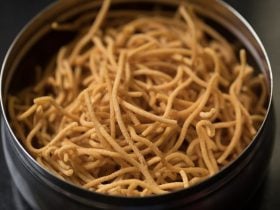






0 Comments